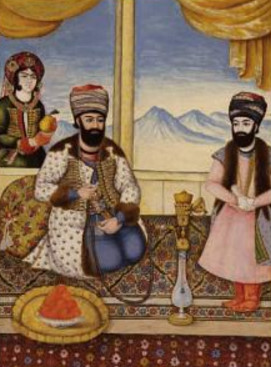Sayed Murad Khan on:
[Wikipedia]
[Google]
[Amazon]
Sayed Morad Khan (
Rulers of Iran
Zand monarchs Year of birth missing Murdered Persian monarchs 1789 deaths 18th-century murdered monarchs People murdered in 1789 {{Iran-royal-stub
Persian
Persian may refer to:
* People and things from Iran, historically called ''Persia'' in the English language
** Persians, the majority ethnic group in Iran, not to be conflated with the Iranic peoples
** Persian language, an Iranian language of the ...
: سید مراد خان), was a ''Shah
Shāh (; ) is a royal title meaning "king" in the Persian language.Yarshater, Ehsa, ''Iranian Studies'', vol. XXII, no. 1 (1989) Though chiefly associated with the monarchs of Iran, it was also used to refer to the leaders of numerous Per ...
'' of Iran
Iran, officially the Islamic Republic of Iran (IRI) and also known as Persia, is a country in West Asia. It borders Iraq to the west, Turkey, Azerbaijan, and Armenia to the northwest, the Caspian Sea to the north, Turkmenistan to the nort ...
who reigned from January 23, 1789 until May 10, 1789. He was the seventh king of the Zand dynasty
The Zand dynasty () was an Iranian dynasty, founded by Karim Khan Zand (1751–1779) that initially ruled southern and central Iran in the 18th century. It later expanded to include much of the rest of contemporary Iran (except for the provi ...
. His brief reign is indicative of the ruthless and brutal struggle for power that prevailed among members of the Zand family following the death of Karim Khan Zand
Mohammad Karim Khan Zand (; ) was the founder of the Zand dynasty, ruling all of Iran (Name of Iran, Persia) except for Khorasan province, Khorasan from 1751 to 1779. He also ruled over some of the Caucasus, Caucasian lands and occupied Basra f ...
in 1779.

Life
Sayed Murad Khan was a member of the court of his predecessor, Jafar Khan, in the Zand capital of Shiraz. It was apparently Jafar Khan's treatment of Sayed Murad Khan that led the latter to plot the king's overthrow. Sayed Murad Khan had been governor of Shiraz but was later confined with his family and, according to one account beaten on Jafar Khan's orders in an effort to force him to divulge his wealth.Malcolm, John, ''The History of Persia, Vol. II, Part 1'',1829 footnote, p. 106. In 1789 a group of individuals, led by Sayed Morad Khan conspired to poison Jafar Khan. A female slave was employed to carry out their wishes. Sayed Morad Khan and his followers overcame the weakened shah, killing him,decapitating
Decapitation is the total separation of the head from the body. Such an injury is invariably fatal to humans and all vertebrate animals, since it deprives the brain of oxygenated blood by way of severing through the jugular vein and common c ...
him and throwing his head from the citadel.
After the murder of Jafar Khan
Jafar Khan Zand, () was the sixth ''shah'' (king) of the Zand dynasty of Iran from 1785 to 1789. He was the son of Sadiq Khan Zand, who was removed from the throne in Shiraz by Ali Murad Khan, who had previously taken Isfahan for himself.
Biog ...
, Sayed Morad became the new Shah
Shāh (; ) is a royal title meaning "king" in the Persian language.Yarshater, Ehsa, ''Iranian Studies'', vol. XXII, no. 1 (1989) Though chiefly associated with the monarchs of Iran, it was also used to refer to the leaders of numerous Per ...
of Iran. Jafar Khan's son, Lotf Ali Khan
Lotf Ali Khan (; ) was the last Shah of the Iranian Zand dynasty, ruling from 1789 to 1794.
Early life
Lotf Ali Khan Zand came to power after a decade of infighting among a succession of violent and inept Zand chiefs following the death in 177 ...
, then marched to Shiraz
Shiraz (; ) is the List of largest cities of Iran, fifth-most-populous city of Iran and the capital of Fars province, which has been historically known as Pars (Sasanian province), Pars () and Persis. As of the 2016 national census, the popu ...
, where he was popular among the people. Sayed Morad Khan held out for a short while in the city's citadel, but after reigning for less than 4 months he was forced to surrender and was executed. Lotf Ali Khan
Lotf Ali Khan (; ) was the last Shah of the Iranian Zand dynasty, ruling from 1789 to 1794.
Early life
Lotf Ali Khan Zand came to power after a decade of infighting among a succession of violent and inept Zand chiefs following the death in 177 ...
succeeded him on the throne on May 10, 1789.
References
Sources
*Perry, John R., ''Karim Khan Zand A History of Iran 1747–1779'', , Univ. of Chicago Press, 1979, pg. 299 *Waring, Edward Scott, "A Tour to Sheeraz by the Route of Kazroon and Feerozabad", , Elibron Classics, 2005.External links
Rulers of Iran
Zand monarchs Year of birth missing Murdered Persian monarchs 1789 deaths 18th-century murdered monarchs People murdered in 1789 {{Iran-royal-stub